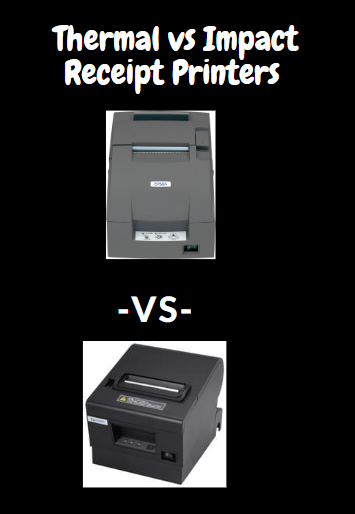If you're in the market for a receipt printer, you've probably come across two main types: thermal and impact. But what exactly sets these two types of printers apart? In this article, we'll take a closer look at the differences between thermal and impact receipt printers and help you determine which one is right for your business needs.

Thermal Receipt Printers
Thermal receipt printers use heat to create an image on heat-sensitive paper. The printer head contains tiny heating elements that selectively heat the paper to produce characters and images. Because thermal printers use heat to print, they don't require ink or toner, making them a popular choice for businesses looking to save money on printing costs.
One of the main advantages of thermal printers is their speed. Because they don't require ink or toner, they can print receipts quickly, making them ideal for businesses that need to process a large number of transactions quickly. They're also known for producing high-quality, easy-to-read prints.
However, there are some downsides to thermal printers. The paper used in thermal printers is heat-sensitive and can fade over time, making it difficult to keep receipts for long periods of time. Additionally, thermal printers are not well-suited for printing on thicker paper or multipart forms.
Impact Receipt Printers
Impact receipt printers, also known as dot matrix printers, use a print head that strikes a ribbon to create an image on paper. The print head contains a series of pins that strike the ribbon against the paper to create characters and images. Because impact printers use a ribbon, they can print on a wider variety of paper types, including multipart forms.
One of the main advantages of impact printers is their durability. They're built to last and can withstand rough handling, making them a popular choice for businesses in tough environments. Additionally, because they use ribbons, the ink lasts longer than it does with thermal printers.
However, impact printers are generally slower than thermal printers, and the quality of the prints is not as high. Additionally, because they use ink ribbons, they can be messy to use and can require more maintenance than thermal printers.
So, which one is right for your business? It depends on your specific needs. If you need to print receipts quickly and want to save on printing costs, a thermal printer may be the best choice for you. However, if you need to print on a wider variety of paper types or require a printer that can withstand rough handling, an impact printer may be a better choice.
In conclusion, both thermal and impact receipt printers have their advantages and disadvantages. By understanding the differences between the two, you can make an informed decision and choose the printer that's right for your business needs.



